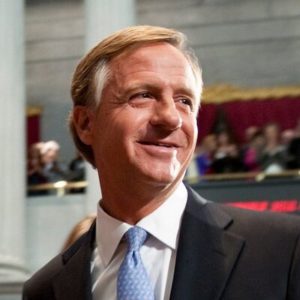Note: John Hickenlooper, a Democrat, was the governor of Colorado. Bill Haslam, a Republican, is the outgoing governor of Tennessee.
About half of Americans say they are starting off the new year with firm resolutions for improving their lives. Many of our states are off to a fresh beginning, too, with much the same goal in sight. By the end of the month, 21 new governors will have been inaugurated across the country, joining Alaska’s Mike Dunleavy, who was sworn in at the start of December.
Together these talented individuals represent a wave of ideas and energy hitting where it will have the most positive impact for the American people — in their states.
That’s because the states are the engines of change in our democracy. While it may be the worst of times in Washington, with unprecedented political infighting and gridlock, it’s truly the best of times in the states. Citizens are involved, communities are resurgent, and progress is accelerating. Congratulations to each of our fellow outgoing governors for their important contributions to this trend.
Bipartisanship has a lot to do with state success stories emerging across the country. This is one of the key messages we both delivered at the Seminar for New Governors put on by the National Governors Association after the elections. As the departing chief executives of our respective states, we were honored to share what we learned in our combined 16 years in office.
Our first exhortation to America’s new state leaders was to leave the campaign trail behind. The more quickly a governor transitions from running for office to running the state, the better for constituents. That means abandoning the “red team” versus “blue team” mindset of elections in favor of an “all on the same team” approach to good governance.
For both of us, our greatest achievements — the victories we’ll one day revisit from our rocking chairs — were the ones that brought disparate interests together. In Tennessee, for example, it is a deeply shared commitment that has brought the state up from the bottom of the national education rankings to post record-high graduation rates and the best ACT scores in its history. Now, Tennessee is considered among the brightest spots in the Southeast for student growth and achievement, and the state continues to improve.
This change didn’t come easily. Even in education, the politics of opposition is stronger than the politics of support. In the case of one of us, progress spanned the tenures of two governors (the first was Democrat Phil Bredesen) from different parties, and there were plenty of lengthy conversations with concerned teachers, parents and communities along the way.
But the Volunteer State is reaping the benefits of sustained cooperation. Together, with bipartisan support, Tennessee made the largest investment in K-12 education in the state’s history, reorganized the higher education structure to empower student success and post-secondary credentials, and saw children of all ages reach new levels of educational success.
For the third straight year, record numbers of Tennessee high school graduates are headed to college — 221,775 students enrolled in community colleges and public universities for the 2018-2019 academic year — and employers that may never have considered Tennessee before are relocating so they can hire from such a capable workforce.
We told this story to new governors so they would know how important it is to keep up the dialogue. In our experience, breakthroughs come right at the edge of defeat, so it’s vital never to lose hope.
This is something we recently saw in Colorado, where a divided government nonetheless put up one of the most productive legislative sessions on record. Scores of important bills passed, many by unanimous vote, as the state’s leaders reached across the aisle to find agreement on stabilizing pensions, addressing a backlog of transportation projects, increasing broadband internet access in rural areas, and bringing new resources to bear on the opioid epidemic, to name just a few.
Incoming governors asked many questions about how they could engineer such results. Among the things we told them was to feed on consensus, not conflict. To lead effectively but listen even more. And when the going gets tough, bring everyone back to one essential question: What does the greatest good for the greatest number of people — in our state?
By and large, answering that question means dealing with the bread and butter issues that are a governor’s domain. Citizens care about the roads they drive to work, the schools they trust with their children, the health care available when they get sick, the safety of the communities they call home and the opportunity available to themselves and those they love.
It’s easy to lose sight of these simple truths in the isolation of the governor’s office, so our last words of advice were for new governors to leave their capitals whenever possible. Perspective is “out there.”
We are ending our terms at this most difficult, busy, rewarding and unforgettable experience of governorship. And we couldn’t be more grateful for having had the chance to serve, not more hopeful for the future than we are now based on what we know of the 22 capable new governors who will continue the work for Americans in the new year.

Governor Bill Haslam

Governor John Hickenlooper












